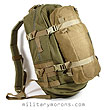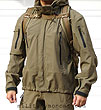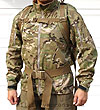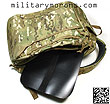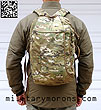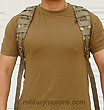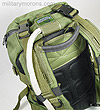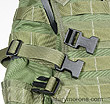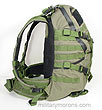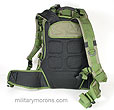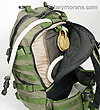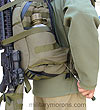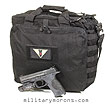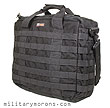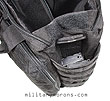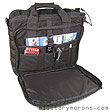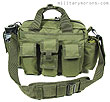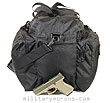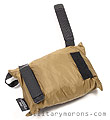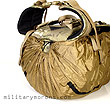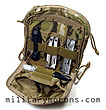Packs/Bags Page 1 Page 2 Page 3 Page 4 Page 5 Page 6 Page 7 Page 8
TO VIEW FULL SIZE IMAGES: USERNAME and PASSWORD are both "mm"
For packs from the following manufacturers, please go to my pages below:
Kifaru
Mystery Ranch
Maxpedition
Arc'Teryx Charlie Pack (discontinued)
| 11/26/06 - From the Arc'teryx LEAF (Law Enforcement and Armed Forces) line is the Charlie pack. Designed as a day/assault pack, it's a lightweight and streamlined design that has more volume than you'd think. The Charlie pack embodies Arc'teryx's efficient usage of space, much like the pockets on their clothing. Hidden or not-so-obvious pleats or folds on pockets suddenly appear and allow the seemingly flat pockets to expand when stuffed. The USMC ILBE Assault pack is based on the Charlie pack, which Arc'Teryx designed and is made by Propper. It was intended to replace the butt pack, allowing easier access to the contents, and worn over body armour. Overall design and features - Here's the quick rundown. Advertised internal capacity is 1650 cu.in., at a featherweight 2 lbs. PALS webbing on the front and sides for attachment of additional MOLLE-compatible pockets. Four side compression straps. One large expandable front pocket for quick-access items. Overall construction is out of 725d Cordura (shown here in Crocodile and MultiCam). Quick-release shoulder straps and stowable waist belt. HDPE frame sheet. Overall approximate dimensions (stuffed out) are 20" in height, 11" in width, and about 8" in depth. The front of the body has six rows of Molle/PALS webbing and five columns. On the lower third of each side are three more rows and four columns of PALS. A two-way zipper with 550 cord pulls that runs 2/3 way down each side is the main compartment access. There is a carry handle sewn into the top of the pack. The shoulder straps are lightly padded and are 2.3" wide - just right for the intended load of this pack. A 1" webbing strap runs the length of the padding, culminating at the bottom where it's a loose end and a sewn-in triglide. The male quick-release buckle is therefore removable/replaceable in case it ever fails. The sternum strap runs up and down the 1" webbing and can be placed at the correct height for the user. An elastic hydration hose keeper is sewn at the top of each shoulder. The Charlie pack has a stowable waist belt. The belt itself is 2" wide webbing, and when tucked behind the back panel in it's own compartment, is practically invisible. The back panel is lightly padded so the QR buckles don't dig into your lower back when the belt is stowed. |
| Inside - The main compartment has an elastic mesh hydration pocket and a zippered compartment for the HDPE frame sheet. The framesheet can be removed from the compartment, but I can't see there being a need to as it's so unobtrusive and lightweight. The frame sheet provides support and shape for the back panel and is stiff enough to distribute some of the load to the waistbelt. The mesh hydration bladder should fit most sizes - shown here is a 100oz camelbak omega bladder. A die-cut Hypalon hose port is sewn into the top of the pack. The main compartment has a drainage gromment at the bottom. The outside compartment/pocket is surprisingly roomy, and covers the front of the pack. It's access via a 12" zipper on the right. When the pack is worn over the right shoulder, the front compartment can be easily accessed by swinging the pack around. Being a lefty, I wish the compartment had an additional zipper on the left of the pack for dual-side access. The four side compression straps keep the contents stable and can also be used for lashing a jacket to the side of the pack. I discovered that they are spaced perfectly for the dock 'n' lock attachment of a Kifaru long pocket, as shown in the photo on the right.
|
| The photos below illustrate the relative size
of the Charlie pack, when compressed and fully stuffed out. It's a great
day-pack size that can cinch down to a very low profile yet balloon
up to carry quite a decent load for its size and light weight. It can
also be attached to a larger ruck to be used as a detachable assault or
day pack.
|
I recently used the Charlie pack as my only
bag for a 2-night trip on a domestic flight. It was completely stuffed,
but fit without problem into the smaller commuter-plane overhead bin.
Coincidentally, as I was waiting for my flight, a Marine walked by with
the ILBE Marpat version of exactly the same pack on his back.
|
| 11/22/09 - The Blade 21 pack from the Arc'teryx LEAF (Law Enforcement and Armed Forces) line is designed as a 'staff bag for meat eaters'. Adapted from the civvie side for the LEAF line, it's essentially a backpack style messenger bag. Named for its volume (21L), it's a sleeker and more comfortable alternative to a laptop briefcase for people on the go. It also makes a great little daypack with good organization. It's available in Crye MultiCam, UCP and Ranger Green. Overall design and features - The Blade 21 is designed with attributes that I've come to associate with Arc'teryx's products - sleekness and spartan exterior design with hidden functionality. It's not covered in external pouches or PALS webbing, and has a very clean looking exterior. One of the more unusual features of the Blade 21 is that all five of its compartments open to the side - it's a side-loading pack vs. the more conventional top or front loader. This was done to allow access to all the compartments without taking it off completely. When the left shoulder is unslung, and the pack retained on the right shoulder and swung around to the front, everything can be accessed. The Blade 21 also features a thermoformed back panel with removable HDPE frame sheet and 7075 aluminum stay. Overall dimensions (approximate) are width 11.5", height 18", max depth 7". Overall construction is of 725d nylon with Hypalon trim. Advertised capacity is 1280 cu in/21L and weight is 3 lbs 4 oz. Outside - The Blade 21 is padded on all sides with closed-cell foam except the side with the zippers, so it maintains some sort of shape even when empty. The exterior is devoid of protruding pockets, buckles or flaps, which makes for a very clean, simple look. There's a top webbing carry handle, as well as one on the right side (when the pack is being worn). The padded, dual-density shoulder straps are contoured for comfort, and have an adjustable sternum strap with buckle in the front. The 2 1/2"- wide shoulder strap pads are sewn with an internal seam - no seam tape is used. The underside of the shoulder pads are lined with a smooth, slightly elastic material. Shoulder strap length is adjusted via ladder locs - there is no quick-release buckle. The same material is used to cover the padded, thermoformed back panel, which has a very cool-looking embossed bird logo near the top.
|
|
Inside - All the 5 pockets/compartments on the Blade 21 are accessed from the right side of the pack. It was designed so that the pack can remain on the right shoulder, be swung around to the front, and all compartments accessed without having to set it down or take it off completely. Great when walking or on the move. All zipper pulls are 550 cord. Top pocket - this is a smaller pocket located on the top of the pack for small items like keys, phone, notebook, snacks etc. It measures 8" wide at the bottom and 6" at the top, and is 7" tall. Accessory compartment/organizer - This is located on the front of the pack, and measures 6" wide and 10" tall. It's meant to be accessed when the pack is on its side, like all the other compartments, so the slot pockets are naturally horizontal (when the pack is vertical). Inside are two slot pockets - one wide enough for a PDA or Blackberry, the other for a multitool or flashlight. The other 3 slots are for pens. The pocket is roomy enough to hold additional items like small notebooks etc. Medium pocket - just behind the accessory pocket is a medium pocket, 9" wide x 9" tall. 2nd main compartment - The '2nd main compartment' is the outer one, and measures 11" wide, 16" tall and 3.5" deep. Main compartment - The main compartment measures 11" wide, 17.5" tall and 3.5" deep and will fit most 15.4" laptops. The two main compartments are separated by sheet of nylon fabric, which is actually slightly oversize so that either compartment can expand into the other. You can therefore have two approximately equal-sized main compartments, each about 3.5" deep, or put everything into one compartment that's about 7" deep in the middle (less on the sides where it's connected). This feature is great for segregating flat items, yet accommodates more bulky items like jackets. To illustrate what kind of bulkier items I could fit into the main compartment, I took the photo below with two standard small .30 cal ammo cans in the main compartment. Frame sheet - The HDPE frame sheet is removable via a zippered opening in the main compartment. A single 7075 aluminum stay in the middle provides rigidity. The frame sheet gives the back of the pack its shape, and also insulates the user from hard objects (laptop) in the main compartment. The aluminum stay is pre-bent to match the shape of the back. I didn't feel a need to change the bend - it was comfortable as-is.
|
The photos below illustrate the relative size of the Blade 21 pack, and how the compartments are accessed by bringing it around to the front when hanging off the right shoulder.
|
Observations and notes - The LEAF version of the Blade 21 differs in the details from the commercial offering. It's made of 725d cordura instead of ballistic nylon, has a webbing side handle instead of a molded one, and different zipper pulls. Other than that, it's essentially the same pack, designed as a bookbag or laptop backpack. Its streamlined profile and shape makes it suitable for travel, and the top and side handles make it easy to grab or retrieve from overhead bins or from under seats on planes. The main compartment holds a 15.4" laptop with room to spare, but might be a tight fit for a 17" laptop (I didn't try one). Since I don't normally carry a laptop, I carried manila folders, a binder, notebooks, magazines, day planner (yes, I still have one) and other items in the Blade 21, which kept them well organized. I rode my motorcycle with it and found it stable enough even though it doesn't have a waist strap/belt - the sternum strap is sufficient. For everyday, around town use, I think that a waist strap is unnecessary, and unless it can be removed or stowed, it usually just hangs down from the pack. So, in this particular design and what it was intended for, not having a waist belt is a plus. Although it isn't designed primarily for hiking, the Blade 21 can also be used as a small daypack; a light jacket, water and snacks are easily carried in it. It doesn't have any port for a hydration tube although I suppose you could route it out the top of the main compartment. Another thing I like about the Blade 21 is how the back panel is contoured to the shape of my back by the frame sheet and aluminum stay. The frame sheet prevents the sides of the panel from pulling away from the back when the pack is full, or has something bulky or oddly shaped in it. Some packs, when stuffed, tend to bulge out in the middle of the back, like a football. With the Blade 21, the back panel contour remains the same, and that's one of the reasons why it feels stable - it feels like it's hugging my back rather than just sitting on it. The Blade 21 is a great little pack for the 'office on the go', general every day use or as a carry-on bag for travel. If simplicity in design is what you prefer, rather than a pack covered in webbing and pockets, this might suit your needs.
|
Eagle Industries FSBE II Patrol Pack
| 8/12/06 - The Eagle Industries FSBE II Patrol Pack (PP) is a small modular patrol/assault pack from the FSBE II kit. Overall design and features - It's designed as a very simple, lightweight day pack with about 1570 cu.in. of internal capacity. PALS webbing on the outside of the pack allow for attachment of molle-compatible pouches. A rear compartment is designed to carry a ballistic plate. Overall seam-to-seam dimensions I measured are as follows: max height 18". Max width at bottom 14". Max depth (including main compartment front 'extension') 10". Body -The PP has a main compartment zipper which extends about halfway down each side. There are four short horizontal compression straps - two on each side. On top of the pack are two radio antenna openings, each covered by a web flap secured by a snap. They can also function as hydration hose ports if a hydration bladder is hung inside the pack. The outside is devoid of external pockets or compartments, but has ample PALS webbing for additions. On the front of the main flap are five rows of PALS webbing. The top row is 4 columns across while the others are 6 rows across. On the sides are three rows of PALS; the bottom two 3 columns wide and the top one 4. On the front of the pack is what looks like an external pocket. It's not; it's the bottom access flap. It extends from the main body, adding some extra volume. It has 3 rows of PALS, 4 wide on top, and 6 columns across for the bottom two. The very bottom of the pack has 3 rows x 6 columns of PALS which can be used for attaching pouches or lash points. The bottom also has four grommets for drainage. The 17" long shoulder straps
(padded portion) are lightly padded and have five rows of PALS webbing
running down their length. There are also two metal D-rings sewn in.
The shoulder straps have quick release SR buckles for immediate doffing.
There isn't any sternum strap, but it's not too hard to rig one up
if needed (see below). |
| Inside - The PP has a single
main compartment, access by the main zipper which extends about halfway
down each side of the pack. There are no internal compartments or divisions
inside the pack. At the top and bottom, are four 1" straps with
ladder locs. I was puzzled as to what they might be used for, and was
told that they are for lashing/stabilizing a particular radio (or radio
pouch) inside the pack. Vertical distance between the top and bottom
tie-downs is about 13" and horizontal spacing is 5" between
them. |
| The back of the PP is padded with what feels
like 0.5" foam. Behind the padding is a large compartment, designed
to carry a ballistic plate. The padding in the back of the pack does a
good job when a plate is put in the pocket. How comfortable it is will
also depend on what type curve plate you have. The velcro-closed top opening
is 10" wide, which is the limiting factor to how large a plate you
can put in the compartment. A velcro flap inside the bottom of the compartment
is adjusted so the plate rides at the correct height. Even though the
compartment is large enough to accomodate most plates, as mentioned above,
you have to get it through the top opening first. A level IV CPC plate
(10" wide x .5" thick) was the limit of what would pass through
the opening. A large SAPI - no way. You can put a hydration bladder there
instead of a plate, however the longer 100 oz bladders are too tall when
full. The shorter, wider baffled bladders would work better. For the velcro
to close, the bladder should not be longer than 13". Width shouldn't
be a problem. There is no waist belt supplied, but one could be slipped through the two openings at on each side at the bottom of the pack. These openings open into the plate compartment (see photo). There are also two metal D-rings at the bottom corners of the pack - a 1" waist belt can also be attached to those. |
| The shoulder straps feel pretty comfortable when the pack is worn alone with a medium load (20 lbs). Lack of a sternum strap doesn't bother me as the shoulder straps stay put. However, when worn with a vest or armour, a sternum strap could come in use to prevent the pack's shoulder straps from slipping/walking to the outside, as they often do when worn over a rig's shoulder straps or armour. I made my own simple sternum strap as shown below: For the sternum strap, I used a short length of 1" webbing, an ITW Ghillietex slotted buckle which I installed on one of the shoulder straps, a common loop which I split with a pair of pliers to install on the other shoulder strap, and an ITW metal slider to secure the end of the webbing (a plastic tri-glide can be substituted). If you're looking for a pack with
lots of internal organization and compartments, the FSBE II isn't it.
For civvie use, it'd do fine as an EDC pack if you don't need any organization,
or a dayhiker that you'd use to throw few larger items in, like a windbreaker,
water, some food and essentials in without the need to segregate small
items. Organization can be achieved by adding external pouches.
|
| 8/8/06 - The Eagle Industries Travel Rolling Equipment Cargo bag - with pockets (TREC-W/P), as its name describes, is a large rolling equipment bag. Okay, it's a huge rolling equipment bag. The concept of duffles or rolling luggage isn't anything new. Most duffles are simple huge 'bags' with a minimum of pockets (if any). Over the past couple of years, the 'loadout' or 'deployment' bag has entered the scene, evolving from the simple duffle into something offering more organization and versatility. With body armour and sometimes the need to transport weapons, these loadout bags can become very heavy and unwieldy. Eagle's combined the loadout bag and rolling luggage concept into a package that makes hauling tactical gear around a whole lot easier. Besides being used for hauling gear and weapons, I can also see it being used for more mundane roles as a road trip bag for me and the wife to consolidate all our luggage into one. Overall design and features - The TREC comes in two different sizes (standard and large), with and without external pockets, for a total of four variants. The one shown here is the standard sized TREC with pockets (W/P) and all information here is for the TREC-W/P only. The TREC-W/P has a main compartment, a large (almost full length) side pocket, two large side pockets and a flat end pocket. It also has a removable aluminum frame with large roller-blade wheels. Just for reference in this writeup, I'll be describing the TREC in the upright/vertical orientation - 'top' will refer to the handle end when you're pulling it on rollers. 'Front' is the side where the main compartment opens. Advertised weight of the TREC-W/P with frame is about 9.5 lbs. Exterior -The
TREC is constructed of 1000D Cordura, and built to withstand abuse
with the typical Eagle quality and workmanship. Overall dimensions
are approximately 38" x 22" x 13" (this includes the
rollers). Stuffing it out will add a few more inches to the width
and depth (last two numbers), as the fabric can bulge out. Bear this
in mind if you intend to use this for air travel, and check with the
airline as the TREC might incur oversize or additional weight charges
for checked luggage. If you're worried about high shipping costs when
buying a TREC, take advantage of
SKD Tactical's $5 flat rate shipping fee and competitive pricing
(update - the TREC is no longer carried by SKD) |
 Double pocket side |
| Frame - The Kelty-designed
lightweight aluminum frame is constructed mostly of 0.75" diameter
bent/welded aluminum tubing with what looks like a powder-coated finish.
It's very lightweight and stiff. The frame slides into the sleeve on
the back of the TREC, providing a rigid platform/shape for the entire
bag. Without the frame, the bag functions like a soft duffle. Overlapping
velcro flaps at the bottom secure the bag to the frame. At the bottom
corner of the frame are four semi-circular gussets which strengthen
the L shape of the frame greatly and protect the sides of the wheels
like little wheel wells. The frame can be used as a stand-alone dolly,
but the gussets will prevent some items from sitting all the way in.
|
Compartments - The rundown on the compartments of the TREC-W/P are as follows:
|
For illustrative purposes, I put some bulkier
pieces of gear into the TREC-W/P, shown below. Inside the main compartment
is a Crye Armoured Chassis, Blast belt, ballistic helmet, Crye combat
pants and shirt, 6004, Revision Eyewear hard case and an M4. There is
a lot of extra space left over in the compartment, as you can see. In
one of the side pockets is a pair of size 9 Lowa Desert Seeker boots
- it'll fit a larger pair of boots. |
TAD
Gear F.A.S.T Pack - Alpha
(Note: This model is no longer available - Gen II is now out, see below)
| 1/14/06 - Triple Aught Design (TAD Gear) is a San Francisco-based adventure gear company with the coolest website intro who carry a long list of top-notch outdoor gear and equipment guarranteed to make just about anyone drool. TAD collaborates with various top manufacturers on TAD Gear exclusives, and also offers products of their own design. The F.A.S.T. Pack Alpha Model is one example of such a collaboration - TAD teamed up with well-known nylon gear manufacturer MAXPEDITION to produce their first pack. Based on TAD's initial concept sketches, MAXPEDITION refined the design through 5-6 prototype phases and this is the result. It's available only through TAD Gear. Overall design and features - The F.A.S.T. pack is a streamlined, 1800 cu.in. daypack with pretty unique styling. It's offered in black or OD green and constructed of DuPont Teflon coated 1000D ballistic nylon. It's a bit stiffer than some other nylons, but in my personal opinion, that's not a bad thing when it comes to packs as it helps the pack maintain its shape. The pack is about 21" high and 14" wide at the bottom. Body - Looking from the side, the top
and bottom of the pack are tapered towards the body resulting in a
streamlined profile that makes the pack quite low-profile when worn.
There is no internal frame or suspension, so the waist belt is there
more for stability than for load distribution. On the front panel
are 2 rows X 6 columns of PALS webbing for attachment of accessory
pouches. There is also the "Transport Tail" (more on this
later), which is a beaver tail on the outside front of the pack which
allows items to be stuffed in between it and the main body. The tail
has 4 rows X 4 columns of PALS on it sewn over two rows of 2"
wide webbing (for ALICE clips or pouches for 2" wide belts).
The sides have 3 rows of PALS on the main body with 3 usable columns.
At the bottom sides are large pockets which will hold Nalgene bottles
with one row of PALS sewn to the outside over a 2" wide strap.
I'd like to see another row of PALS added just below that to stabilize
pouches attached there. |
| Inside - The F.A.S.T. pack is more of a panel loader
than a top loader, with the main compartment being accessed via the
front panel which zips open halfway down the pack body. The front panel
has a spacious outside zippered pocket and inner mesh compartment. Both
are about 10" X 10" in size. Water-resistant YKK zippers are
used for the main compartment and outside pocket which help protect
the contents from moisture. I found the metal zipper pulls noisy, so
I cut them off and replaced them with para cord.
|
| The "Transport Tail" is essentially a beaver-tail for stowing
stuff on the outside of the pack. The side compression straps feed into
the tail, keeping it snug to the pack body. The tail has four buckles,
with female buckles at the top left and lower right corners and male buckles
at the bottom left and top right. This arrangement allows the tail to
be folded over and buckled to itself to form a pocket for the butt of
a rifle or similar load. The side compression straps then connect across
the pack to each other to secure the load. To make this buckle scheme
work, the lower left and top right side compression straps were adjusted
with triglide, which made them inconvenient to cinch up (see 'original'
photo below). Every time I wanted to cinch up the compression straps,
the one with the triglides were very slow to adjust; I had to pre-adjust
their length or use the triglides. I solved the issue by replacing the
triglide/female buckles with a single adjustable female buckle (ITW Fastex
part #101-1100
for the dual adjust buckle) with ladderloc. Luckily, the ITW Fastex female
buckle is compatible with the UTX-flex buckles used on the F.A.S.T. pack.
All four side compression straps now work as they should and equal tension
can be achieved.
|
The relatively streamlined, 'turtleshell' profile of the F.A.S.T. pack is apparent in the photos below. It rides high on the back, and does a good job of conforming to my build. As mentioned before, the waist belt is for stability, not support. The side pockets fit USGI 1-qt canteens perfectly - the side compression straps should go over the nalgene bottle for added security. I strapped an M4 to the pack using the transport tail and compression straps, and found that it worked as advertised. I'd use a couple of extra straps 'just in case', in addition to the compression straps, though. My only concern for heavier rifles or loads is that it puts the c.g. of the pack further away from my back. I'd probably strap a rifle to the side instead, and use the transport tail for light loads like a jacket or poncho liner. In the beaver tail role, it's very quick and convenient. I'd limit the total load to about 35 lbs for the pack - more than that and I'd recommend a pack that has a suspension to distribute the load between the shoulders and hips. In summary, the TAD F.A.S.T. pack is a well constructed day pack that's relatively comfortable and low profile, with some interesting features, something that I'd use it in place of my Becker.
|
TAD
Gear F.A.S.T Pack - Alpha, Gen II
(Note: This model has replaced the one above)
| 6/10/06 - Triple Aught Design (TAD Gear) has introduced the second generation (Gen II) of their F.A.S.T. Pack Alpha Model reviewed above. If you haven't already read the review on the Gen I pack, please read it first, as I'll be focusing on the changes instead of reiterating the writeup above. If I didn't mention it here as a difference, you can assume that the Gen II shares the spec as the Gen I. Also, do visit the link to TADGear's F.A.S.T pack page for lots more detailed photos. The Gen II is not made by MAXPEDITION, and quality/workmanship looks to be on par with the Gen I product. Overall design and features - The Gen II F.A.S.T. pack at first glance, looks almost exactly like the Gen I. But looks can be deceiving as quite a lot has changed in the details. Overall, the Gen II retains the same capacity, profile and look of the Gen I. It's still offered in black or OD green and constructed of 1000D Cordura nylon. It's not as stiff (some might prefer that), but is more heavily coated on the inside with waterproofing. This results in a slightly abrasive coating, which is most noticeable when shoving your hand down inside the pack or pockets, but not really much of an issue. I'd like it to be a bit smoother, of course. The OD green of the Gen II is slightly 'grayer' than the Gen I, and the material is different as well. Accurate colour representation is very difficult on a computer screen. In the studio-lit photos, the webbing looks a lot greener than it really is. There's actually less contrast between the webbing and pack material than the studio photos show. The photo right below was taken under natural light, with the Gen I on the left and Gen II on the right, and is a more accurate representation of the actual colours. Body - The Gen II shares the overall features as the Gen I - waterproof external zippers throughout, four compression straps, and the same configuration of PALS rows and columns on the sides, body and transporter tail. Note that the 2" webbing under the 1" PALS webbing is gone. The issue with the Gen I compression straps has been fixed - all four are now adjusted easily without triglides. Equal tension is easy to achieve. The shoulder straps are 3" longer than the Gen I and now have quick-release buckles instead of ladder locks. The Gen I straps fit me fine, but could have been a bit short for someone of larger stature or when worn over bulkier clothing or gear. The Gen II's longer straps should fit a wider range of heights and builds. One thing I'd like to mention is that the metal zipper pulls are noisy - they 'clink' at every move. I've since cut them off and replaced them with 550 cord pulls (on both the Gen I and II) - something I'm sure many users will do when they get the pack. The Gen II is sterile on the outside - it is sans logos or manufacturer tags. Instead, where the TADGear patch used to be located just below the top front pocket zipper, there is now a 3" x 10" strip of black loop velcro. TADGear chose black velcro instead of OD to maintain the contrasting look of the pack with it's black zippers, buckles and mesh. The patches shown attached are all from TADGear's patch selection. Also new on the Gen II is the removable waist belt,
which doubles as a molle-compatible padded belt when removed. It has
15 columns and two rows of PALS webbing on it for attachment of molle-compatible
pouches. The bottom of the mesh back panel forms an open-ended sleeve
for the belt. A velcro patch on the belt mates with one on the inside
of the sleeve. A velcro strap on each side of the pack passes through
the plastic common loops on the belt to secure it. Definitely added
versatility to the F.A.S.T. pack. The 2" straps on the ends of
the waist belt are really long - TAD could have made them
shorter to eliminate some excess. As they are right now, they'll fit
up to a 72" waist. The belt can also be tucked away behind the
sleeve when not in use. |
| Outside details - Each major compression strap has a velcro keeper to keep strap ends rolled up. The excess length of webbing is simply rolled around this keeper, then either secured to the strap, or the roll left loose (hanging, but shorter than before). It's a nice touch and keeps all straps nice and neat. The Gen II retains the two side pockets that will fit a Nalgene bottle or USGI 1-quart canteen. Concealed under the right side pocket is a cool new feature - the Flashlight Cave. It's a bottom-opening pocket with a velcro closure. Attached at the inside top of the Cave is a D-ring with a Civilian Lab retractable plastic-coated steel cable lanyard about two feet long (included). The retractable lanyard is removable and can be used elsewhere. Any flashlight with a lanyard hole can be attached and easily accessed on the go by reaching back and grabbing it. The light can be left hanging outside the Cave, or shoved back inside with one hand and the Cave closed. You're not limited to a flashlight, of course, and a folding knife or multi tool can be attached just as easily with a keychain split-ring and used at a moment's notice without fear of loss. The "snack pocket" on the re-designed Transporter Tail has been eliminated on the Gen II pack. Instead, a reinforced rifle stock slot has been incorporated. While the tail can still be folded and the tail buckles snapped together to form a pocket for a rifle stock, the stock slot is a more secure (in my opinion) receptacle for the rifle stock as it's deeper and the tail buckles/straps can be snapped around it and tightened (see pics below). An M4 carbine stock is completely enclosed by the stock slot. While the snack pocket is gone, a new larger pocket is now located on the main body behind the transporter tail (shown below with a magazine sticking out). Inside - The hydration bladder pocket (which I thought could use some improvement on the Gen I) is gone on the Gen II. Hydration bladders now have their own external compartment, accessible from the outside of the pack. The zippered-opening compartment is located just behind the mesh back panel. It'll fit most bladders, and is a great improvement over the Gen I system. Access is easier, and the bladder is much better supported in its own compartment. The hose is routed through a slot in the compartment liner (which separates it from the main pack compartment), then out the top of the pack through the same slot as on the Gen I. Inside the main compartment, the large mesh pocket on the front flap is still there. The sewn-in internal organizer has been replaced by a removable/reversible organizer suspended in the pack by two common loops and velcro straps. User can choose to use the provided pockets, or attach some low profile pocket to the 3 rows x 4 columns of PALS on the other side. |
I didn't take any photos of the Gen II worn by itself because it looks pretty much identical to the Gen I in overall size and shape. I did show how the new transporter tail stock slot works, though. You can see that the M4 stock is completely enclosed and secured by the tail straps. TADGear has done a good job of listening to user input on the Gen I and implementing changes/upgrades in the Gen II F.A.S.T. pack. Usually when an improved, 2nd generation item is introduced to the market, it's priced the same or a little higher than the item it replaces. Instead, the price of the Gen II is significantly less than the Gen I! That's something we don't see too often.
|
| 7/17/07 - The Maratac Force Multiplier Bag from County Comm is a largish-sized bag that would make a good patrol car bag that can be configured for carrying your laptop, paperwork, binders, files etc, as well as 'bail out' tactical equipment. It's covered on three sides with PALS webbing, so its capacity can be expanded by the addition of MOLLE-compatible pouches. The bag is constructed of 1000D ballistic nylon and uses YKK zippers and Duraflex plastic hardware. Out - The outside dimensions of the main bag are 16" long x 13" tall x 5" wide. The outside/front pocket adds another 2" to the width. On the back panel, there are 5 rows x 10 columns of PALS webbing. On the sides of the bag are 5 rows x 4 columns of PALS. Underneath the side PALS is a slot pocket on each side, 11" deep and 5" wide (shown below with two M4 30-round mags). I've attached an EMDOM 6o4 pouch and MAXPEDITION mini-rolly to one of the sides for illustration. A 2" wide removable shoulder strap with reversible pad is supplied. One side of the pad is nylon, the other has a non-slip rubbery surface. The carry handles are made of 2"-wide webbing and wrap around the bottom of the bag for strength and support. On the front pocket is a 6" x 3" loop velcro patch (EOD Robotics patch shown, but not included). |
| The top of the bag has a full sized flap opening, with zippers on each side. A 550 cord loop connected the zipper pulls and is pulled to open or close the flap. The end of the flap also secures with velcro. A 9" x 3" portion of the flap is covered in loop velcro for velcro-backed patches if need be. There are also 3 rows and 2 columns of PALS (and 2" wide webbing) for the attachment of a small MOLLE or belt loop pouch. Inside - The main compartment is padded with foam on the front and back panels, as well as on the sides and bottom. The inside lining fabric is a little bit loose, so I'd have liked to have seen it more taut, or maybe laminated or sewn down in some places. Inside, at each end of the main compartment is a slot pocket, 10" tall x 5" wide (shown below holding two M4 30-round mags). At the bottom of the main compartment is a strip of loop velcro, to which the removable divider/pistol attachment panel secures to. The padding in the bag gives it some shape/rigidity - it's not a soft, floppy bag. The removable panel is covered on both sides with loop velcro and measures 14.5" x 11". It's very stiff, and will support the vertical weight of a pistol and loaded magazines. It's supplied with a pistol strap and two elastic looped magazine/light holders, all of which can be positioned anywhere on the panel. Each elastic loop holder has three slots and will fit three magazines. |
| Outside pocket - The outside compartment/pocket is zippered on both side and the top so it opens out completely. It's padded as well, so it can be used as a padded mat when opened. The compartment measures 14" x 11" x 2". There's a SR-buckle secured sleeve for a laptop (or flat items like magazine publications or files). In front of that are slot pockets - five pen slots, a 2.5" wide slot, and 5.5" wide slot for small notebooks etc. All of them are 5.5" deep. Because of its shape, it's more suited to tall and narrow items rather
than short and wide. It's sturdily built, and I wouldn't hesitate to
load it up with some weight. I think the Maratac Force Multiplier bag
will serve the 'tactical briefcase' role well, to cover administrative
needs while being able to carry other tactical equipment or emergency
gear.
|
County Comm Gen 5 Bail Out Bag
| 10/7/06 - The Gen 5 Bail Out Bag (BOB) from County Comm is a small-medium sized bag that was designed for personal gear, or as a last-ditch bail-out bag with some essentials. It's larger than the EOD Utility bag reviewed below, but not so large as to be overly bulky. It's made of nylon with YKK zippers throughout, and available in black, coyote and olive green. It's made overseas, and the savings are passed on to the consumer, which accounts for the very reasonable price of the BOB. Out - Most of the organization is on the outside. There are no internal pockets in the main compartment. The dimensions (seam to seam) of the main bag body are 13" x 9-3/4" x 4". The handles are made of 2"-wide heavy duty webbing that wraps around the entire bag. A small snap keeper holds the handles together at the top. A 2" web shoulder strap is removable and attaches to D-rings at each end of the top zipper opening. The shoulder strap hasa removable pad, held on by 3 velcro tabs. Pockets - Here's a rundown of the pockets/compartments on the outside of the BOB. I really don't know which is the front or back of the bag - either one could be it, but I figured the one with the smaller pockets would be the 'front', as I usually end up carrying with them facing out.
|
| Inside - As mentioned above,
all the compartments are on the outside of the BOB. The interior is
lined with soft polyester which provides some padding and protects the
contents. A stiff divider velcroes inside the compartment and can be
positioned anywhere, as the velcro sticks to the liner. The divider
has an extra flap which can be opened to divide the main bag into three
compartments. Using it - When we first got the BOBs, my wife and I used them as airline carry-on bags which we stowed under the seats. They're not so large that you're going to load them up too heavy, but roomy enough to carry quite a bit of stuff. My wife carries her laptop, books etc. It's too small for large 3-ring binders, but I was able to fit a 11.5" x 11" x 2" binder inside. It's a size that will see a lot of every day use, and it's a very good value for the price. |
County Comm "IS-100" 72 Hour Response bag
| 12/9/06 - Yet another good value from County Comm is the "IS-100" 72 Hour Response bag. It's designed as a 3-day nylon travel bag that will hold three days of equipment for whatever the scenario, or as a well-organized equipment bag for responders etc. I recently took it on a road trip, which coincidentally happened to be 3 nights, and I was able to put everything I needed, including my sleeping bag, inside the 72 HR bag. It's not a huge bag, like some of the duffles or equipment bags that will swallow a small person, and it's not a 'medium' bag either. I guess I'd call it a 'largish' bag - bigger than an overnight or range. Fully stuffed out, it's too large to use as a carry-on on flights. I asked Nick at CountyComm where the name 'IS-100' came from, and he pointed me to this link: http://training.fema.gov/EMIWeb/IS/is100.asp Outside - I'm
going to refer to the side of the bag with the two pockets and velcro
patch as the 'front'. Overall seam to seam dimensions (including pockets)
are as follows: length 20", width 12", height 14".
Stuffed out dimensions are greater as it'll bulge out substantially.
A Glock 19 is shown in the photos below for scale. At first glance,
the 72 HR bag has two pockets in front, a main compartment, a single
large pocket on the back, and a pocket on each side. The handles are
2" wide webbing that wraps under the bag for strength. I'd like
to see a velcro wrap that enables them to be attached to each other
if desired. A 2" wide removable/adjustable shoulder strap with
removable shoulder pad connects to the plastic hardware on the sides.
The bottom of the bag has a tough-feeling laminated material referred
to as 'TacHard', which is waterproof and abrasion resistant. |
| Pockets and compartments - The organization this bag has is its best feature, in my opinion. I'm going to start at the 'front' of the bag, and work my way to the 'back'.
Using it - This bag offers a lot of organization/compartmentalization, which I really like for separating different items. Of course, if you don't need such organization and only have a few large items, then a duffle might suit you better. The ability to add specialty-sized MOLLE pouches is a plus, although it's got enough compartments that I haven't yet needed to add internal pouches. It can be used to carry additional MOLLE pouches for a rig, ready to interchange out. It's lightweight for a 'largish' sized bag, and so far, seems tough enough. Visit CountyComm's photo gallery for more photos of this bag.
|
| 3/10/06 - The EOD Utility bag from County Comm is nifty little bag that can serve quite a few different roles. Inspired by the military claymore bag, it was designed to be small enough to fit under truck seats but modular so more capacity could be added to the outside. Out - Overall dimensions are approximately 12" x 8" x 5". The material used is a khaki nylon (only this colour is currently offered) laminated with a waterproof material on the inside. A 2" wide web handle is sewn on top. On the front of the bag are 4 rows x 12 columns of PALS webbing. On the rear of the bag are 4 MOLLE-compatible straps that allow the bag to be attached to any PALS webbing. At first glance, the spacing of the straps looked a bit strange, because the columns alternate between 2" and 1" wide, instead of 1.5", but the straps match up perfectly with evenly-space PALS webbing. note, however, that it take 7 columns of PALS, so if the item you're attaching it to has even columns of PALS (bartack in the middle), it'll be offset a column from the center. If you've got odd columns (column in the middle), it'll be centered. A mystery is the use of small Scovil snaps on the straps instead of the larger, standard size. Makes no difference in function that I can see, though. On the bottom of the bag are 6 rows x 2 columns of PALS for attachment of MOLLE compatible items. It has a sand-resistant YKK zipper closure and D-rings on the sides for attachment of the 2" wide shoulder strap. The shoulder strap could use another 6" of length. It's more than long enough for me, but I'm a small fellow, but might be a tad short for tall folk or when worn over bulky clothing or gear. In the photos, I've got about 3" of length left, and I'm 5'7" and wearing it over my shoulder without gear. There is also a 6" x 1" loop velcro tape for labels or tags on the top of the bag. |
| Inside - Inside the outer panel is a large mesh compartment. The opening has elastic and it's closed by a flap with velcro. The flap can be tucked inside the compartment if desired. On the opposite inside are two compartments. Each is about 7" tall x 6" wide, and pleated. A small velcro patch closes them, and a pull tab is provided for easy opening. Taller items will just stick out past the top. Each compartment fits 2 M4 30-rnd magazines perfectly. At the bottom of the bag is a grommeted drain hole. It has a piece of webbing sewn over it, to prevent too much dirt from entering, while allowing sand and water to drain. Inside each top corner is a 550 cord loop for dummy cording items to. Also provided are small Scovil snaps. I don't have anything that uses these size snaps, but CountyComm said that they're meant for snap-in dummy cords, which they'll have at a later date. I'd have picked standard size snaps instead, or a small plastic snap hook to make it more universal. Using it - I looked around to see what common item I could fit inside the EOD bag to give the reader a size reference. I found that a common U.S. military 200 round 7.62mm ammo can in the main compartment plus four M4 30-rnd mags in the two pockets fit inside it with room to spare. It's a tight fit for 8.5" x 11" paper or magazines, but if you don't mind dog-ears, it'll carry them. I found that it's the perfect size for everyday civvie use as it's large enough to carry what I need, but not too much larger than I need. With two double M4 mag pouches on the outside (see left photo below), it makes a great range bag for mags. 8 M4 mags on the outside, 4 more inside in the two pockets, handgun and mags in the mesh pocket and rifle/handgun ammo in the main compartment plus hearing protectors and it's good to go. At the price it's offered at, it's a very good value. County Comm also sent out the MPCC (Multi-Purpose Carrying Case) which is shown below attached to the shoulder strap of the EOD bag. It's meant for their small GP-4L short wave radio. It'll fit items about 4" x 2.5" x .8" like small radios, call phones or i-pods. It has a soft, plush, padded interior to protect the contents. A simple velcro flap closes the case. There's a small opening at the top/back to pass an earphone wire through. In front of the main compartment is another pocket for business cards or the frequency list of Armed Forces radio stations. It has a tri-flap attachment method for horizontal carry on belts or straps up to about 2.5" wide. The three flaps overlap and are extremely secure - it's not coming off what it's attached to. There's a 3/4" wide piece of webbing on the rear flap which can be used for vertical carry on a 2" belt, but it's secure but not stable, as it tends to pull the flap open. It's primarily meant as a dummy cord attach point so it doesn't get lost in a pack. For a civvie like me, it makes a great pouch to put on pack straps for my compact digital camera or cell phone. The Razr case on the right is slightly larger than the MPCC case. It was sized for the Motorola Razr phone, but fits other small items or electronics (sized not more than 5" x 3" x 1") that might not fit into the MPCC case.
|
| 7/8/06 - The EOD Utility bag is now available in OD Green and Black (OD shown here). Same model as the Desert Sage one reviewed above. Usage update - I've been using the EOD bag almost daily to and from the office for the past 4 months, as I have very minimal needs. I found that the shoulder strap would sometimes get twisted, as the plastic snap hook is able to rotate. I injected some hot glue around the head of the snap hook, where it inserts into the strap loop, to prevent it from rotating and that worked well for me. I replaced also the black cotton zipper pulls with 550 cord. Since gas prices jumped through the roof, I've been riding my motorcycle to work at least three times a week and leaving the car at home. The EOD bag works very well as a 'messenger' type bag. I added a waist strap I threw together out of 1" webbing, and attached it to the bag with siamese slik clips. This stabilizes the bag when I'm on the bike and keeps it from swinging around to the front. Accessing the EOD bag is faster than a small backpack as all I have to do is swing it around without taking it off. In the pics below, also shown is the Padded Knife/Utility tool pouch. It's a little padded pouch that will accomodate a large folding knife (Strider SMF shown), or any other similarly-shaped item. It was a bit too snug for my cell phone, which I normally carry on the MPCC case mounted on the shoulder strap, but might fit smaller models. It's molle-compatible with a single attachment strap and has a velcro/snap lid closure. |
| 1/22/07 - OR Gear's pack cover is a lightweight, durable, waterproof cover designed to keep your pack dry in wet weather. It's made out of coyote tan HyrdoLite ™ waterproof, coated fabric. It comes in its own pouch that can be attached to the PALS webbing on the outside of a pack, using OR Gear's Qik-Stik® attachment system. It's a good idea to keep it easily accessible, ready to be deployed at the first sign of rain. The cover actually compresses into a smaller package than the pouch, and can fit into a smaller one if need be. |
| The cover measures 40" x 15" x 13" for a volume of
about 6500 cu.in. All seams are taped, and there are two daisy chains
on the outside. There are two elastic shock cord drawstrings - one for
the main opening around the back, and another at the bottom. The cover
is large enough to fit over the Kifaru ZXR shown below, with room to
spare. The shock cord is cinched up and covers all of the pack except
the back panel, shoulder straps and waist belt. In wet weather, given
enough time, water will always find its way and soak into the fabric
from the exposed shoulder pads, hip belt and back panel (when water
runs down your back). But, the OR Gear cover will keep the rest of the
pack dry, and slow down the 'soaking' process considerably. In the photos
below, the lighting makes it look lighter than it is. The photos above
are a better representation of the true colour. |
| 11/7/08 - From Mil-Spec Monkey (MSM) comes the MSM Loop Panels. These are used for holding items in position within loop velcro-lined compartments in bags, packs etc. MSM noticed more gear utilizing loop velcro areas for modular attachments but also noticed that there was a lack of good modular attachments on the market. So, he designed these. Description - The Loop Panels are 5" x 2" in size, and have hook velcro on the bottom of the base. A stiff plastic insert provides a very rigid platform that prevents the panel from bowing when items are inserted into the elastic loops. Wrapping around the plastic insert is stiff webbing with elastic woven into it, providing two bands of grippy rubber for retaining items. The next layer is the gray/foliage green 2"-wide elastic which forms two loops for pistol mags, etc, in the middle. Over that layer is yet another one of 1.5" black elastic that forms one large loop. Both layers of elastic are sewn down 0.5" from the ends to form smaller pen loops.
|
Items inserted into the gray loops are held quite securely by the exposed rubber on the base. They not to hard to pull out and provide just the right amount of resistance. The black loops rely on tension to retain the items and for heavier things like rifle mags, two panels might be needed if vertical orientation needs to be kept. However, these are designed for use inside bags, so the black elastic is more than adequate to prevent a rifle mag from shifting around in a compartment - it doesn't have to support its weight fully. When loaded up, the panels remain flat instead of pulling away from the attached surface at the ends. I've shown a panel in use above in the front pistol compartment of an EMDOM TNT bag. They do add a bit of thickness over non-stiffened velcro loops, but only about 0.25". Very nicely made and they work advertised. If I had one concern, it'd be about the longevity of the gray elastic. After storing mags in the loops for a week or so, it lost a bit of its elasticity and loosened up a bit along the edges. Still retains the mags, though, plus the black elastic is there as 'backup'. The MSM Loop Panels are sold in pairs. I must also mention MSM's wide array of custom patches either designed or drawn by MSM himself. He's quite the graphics whiz. They've proven to be very popular and he's got a wide selection. All are embroidered and have velcro backings.
|
| 4/18/09 - The Mil-Spec Monkey Util/Admin Pouch is a follow-on to their MCAP, which was another multi-purpose organizer that could be attached to a vest or pack. Rather than using the velcro flap closures as on the MCAP, the Stealth has zipper closures instead for quieter access; hence the name 'Stealth'. Description - The Stealth pouch measures approximately 6.75" wide, 6.25" tall and about 2.25" thick. Stuffing it will increase the front-back thickness, as it can expand. There is a front compartment and a main compartment. The front of the pouch is covered with a 6" x 4.5" loop velcro field. On the rear is webbing for malice clips - the pouch can be mounted using three or four columns of PALS. There are web loops on the sides for attaching molle pouches if desired, or shoving a chem light there. Overall construction is 1000D cordura with 500D used to reduce bulk and weight where possible. The Stealth is manufactured by Tactical Tailor in collaboration with MSM, and is available in black, tan, UCP, OD green and Crye MultiCam (on a limited basis). Front compartment - The front compartment opens out flat, with the zippers going down all the way on either side. There are two slot pockets; one on the body and one on the flap. Three elastic loops are sewn to the front of the pocket on the body. On the flap slot pocket, there are four elastic pen loops. Loop velcro is sewn at the bottom of the compartment to which the removable map case is attached. The map case will accommodate flat items folded up to 9" x 4.5".
|
Main compartment - The main compartment zippers extend about a third of the way down each side, so it doesn't open out flat. At the rear is a slot pocket with two rows of elastic sewn to the front. The top row has a large loop and a medium loop while the bottom row has three medium loops (for multitools, folding knives, pistol mags etc). On the other side of the compartment are two rows of elastic, with the top and bottom row configuration reversed from the pocket (large loop on bottom row). The main compartment will expand quite a bit to hold bulkier items. If I were to change something on the Stealth, it would be to extend the main compartment zippers halfway down instead of a third (and move the side webbing down or ditch it), so that I could get better access to the inside. Using elastic instead of slot pockets sometimes requires two hands to insert an item, especially if it's to be held snugly. With slot pockets, you just shove the item down. With elastic, one hand has to hold the elastic open while the other inserts the item. With both sides of the main compartment filled up, access can be a bit cramped and would be easier if it opened wider. I have more use for a utility/admin pouch on a pack than on a vest, which is why I put it in this section vs. 2nd line gear. I've no doubt that others who use admin pouches on a vest or body armour would find the Stealth pouch to be well made and able to organize smaller items very well. I mounted it to the front of my Arc'Teryx Charlie pack, which itself doesn't have much organization for smaller items. There, it looks like it was made for it.
|
ATTENTION! PLEASE DO NOT LINK DIRECTLY TO MY IMAGES
-
IT RESULTS IN MY BANDWIDTH ALLOCATIONS BEING EXCEEDED,
AND MY PAGES GO DOWN. THANKS!
/ . PLEASE
OBSERVE AND RESPECT OUR COPYRIGHT! . /
©opyright by MilitaryMorons.com. All Rights Reserved. Reproduction, Duplication,
Distribution Strictly Prohibited.
Unless mentioned otherwise, content and images are the
property of militarymorons.com and are not in the public domain.
They are not to be used without
permission. Please Contact
me for permission to use any images or content herein.









